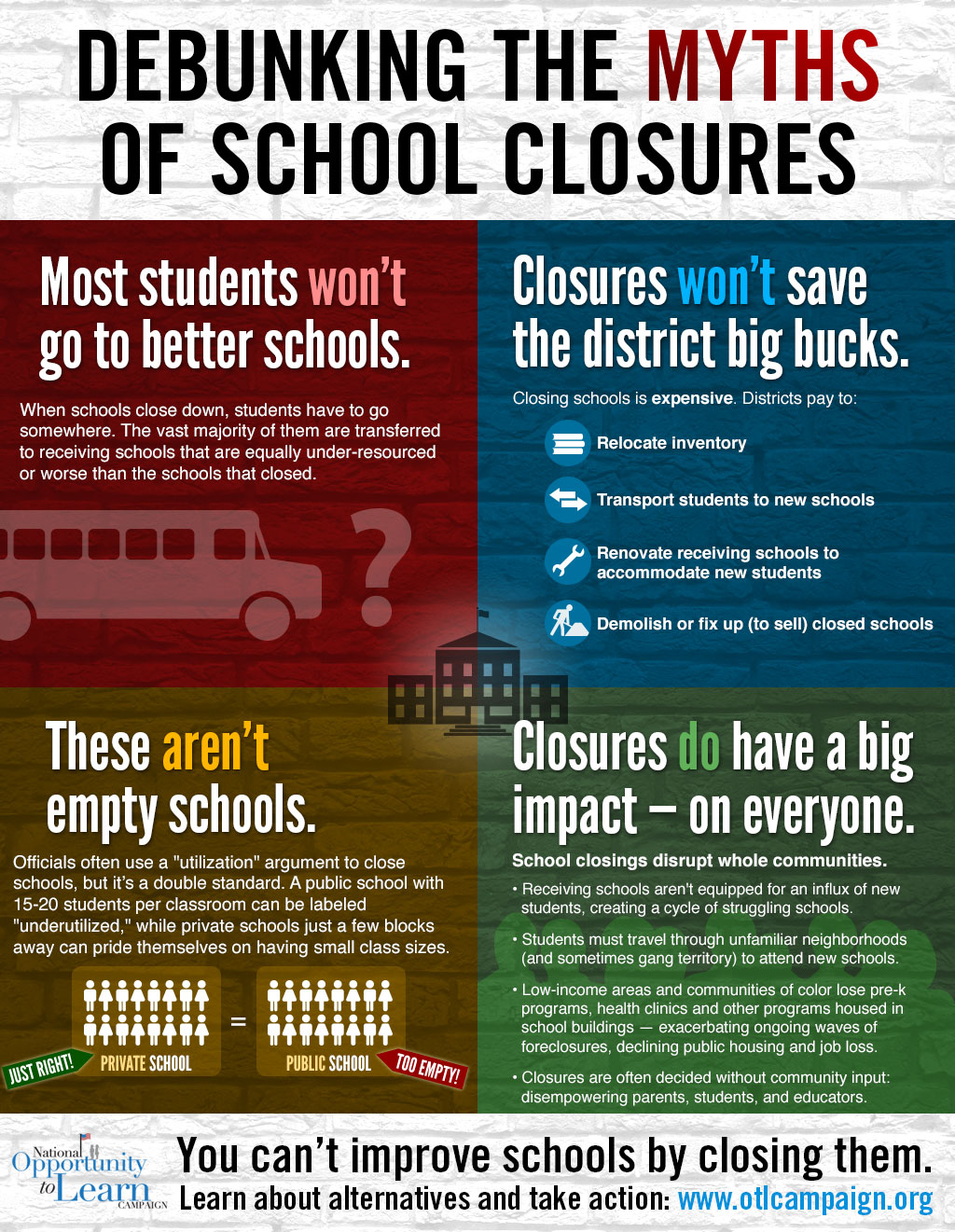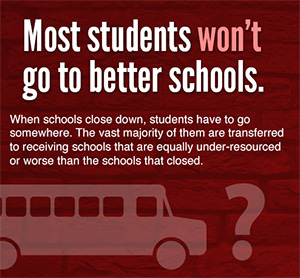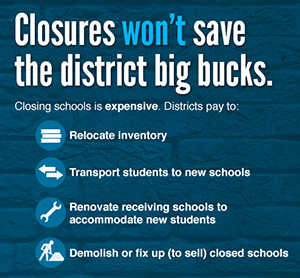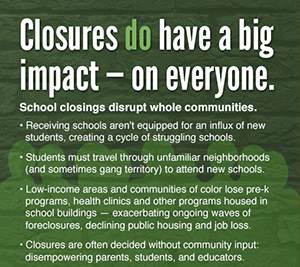Infographic
Debunking the Myths of School Closures
In cities across the country, education officials are closing public schools en masse, impacting thousands of students, disproportionately those from communities of color or low-income families. Officials use a variety of justifications to defend the closures, citing everything from budget concerns to promises of better opportunities for students. But as this new infographic from the OTL Campaign illustrates, these justifications don’t hold up to scrutiny.
Here is what the evidence from past and current school closures says:

Digging Deeper: More information
Most students won’t go to better schools.

The vast majority of students from closing schools are transferred to receiving schools that are struggling just as much as or worse than the schools that closed.
- A February 2013 report from Research for Action compares 32 schools recommended for closure or consolidation in Philadelphia with the 51 planned receiving schools. Overwhelmingly, the receiving schools posted similar or worse scores on the state math and reading exams and were in similar corrective action plans for failing to meet adequately yearly progress.

- A 2009 University of Chicago report on the effect of past closures in Chicago found that 40% of students from closing schools transferred to receiving schools that were on probation. 42 % transferred to schools with scores on the Iowa Tests of Basic Skills in the lowest quartile. Just 6% of students transferred to receiving schools with scores in the top quartile, most of them traveling well outside their designated attendance area to find a school with open seats.
Closures won’t save the district big bucks.

Closing schools is expensive. Officials have to pay to relocate and store inventory; transport students to new schools; renovate receiving schools to accommodate the influx of new students; reassess, fix up, and maintain or demolish closed school buildings. It can particularly difficult to sell closed school properties because they are often in economically disadvantaged areas with little investment, which forces the city to continue maintaining the properties.
- A 2012 audit of the closure and consolidation of 23 schools in Washington, D.C. in 2008 found that total cost of the closures was 39.5 million, roughly 4 times what the district was expected to save.
- A WBEZ Chicago report about the city’s current plans to close 50 public schools this fall notes that education officials have used the school district’s $1 billion deficit as justification for the closures. Simultaneously, those officials are planning to put all the savings from the closed schools, plus an additional $329 million from new bond sales, towards improving the receiving schools. So not only is the district not saving money, it’s going further into debt.
- A 2011 report from the Pew Charitable Trusts examined the cost of past school closures in Chicago, Detroit, Kansas City, Milwaukee, Pittsburgh and Washington, D.C. The report found that “no district has reaped anything like a windfall” from selling or leasing closed school buildings because they are costly to maintain and are often located in low-investment areas with few interested buyers: “As of the summer of 2011, at least 200 school properties stood vacant in the six cities studied – including 92 in Detroit alone – with most having been empty for several years…Milwaukee spends more than $1 million a year maintaining vacant buildings, Pittsburgh $2 million, and Kansas City close to $3 million.”
These aren’t empty schools.

In determining the optimal number of students in a given school, education officials employ a double standard in terms of classroom “utilization.” Despite the documented benefits of small class sizes, a public school with 15-20 students per classroom can be labeled “underutilized,” while private schools (to which many politicians send their children) and charters just a few blocks away can pride themselves on having small class sizes.
- In Chicago, an analysis by researcher Jeanne Olson and a WBEZ report both highlight that the city’s utilization formula assumes from the start that every school should have 30-36 students per class. Anything less and the school is deemed “underutilized.”
Closures do have a big impact – on everyone.

School closings impact and disrupt whole communities.
- Many receiving schools aren’t equipped for an influx of new students. Though the receiving schools may get some additional resources from the district, chances are it won’t be enough to accommodate the needs of the incoming students, most of whom are from low-income communities. This creates a cycle of struggling schools and sets up the receiving schools for future closure.
- Students from closed schools will have to travel across unfamiliar neighborhoods to get to their new schools. This is a particular concern in Chicago, where some students will be forced to walk through gang territory.
- During non-school hours, school buildings often house pre-K programs, health clinics and other community programs. Closing the buildings destroys this hub of community resources.
- School closures fit into a larger pattern of community disinvestment, declining public housing and unemployment. Many of the neighborhoods with closing schools have seen their hospitals and police stations closed as well.
Want to take action? Here’s what to do.
Read up on the alternatives. You can’t improve schools by closing them – here’s what we should be doing instead to support and turn around struggling schools.
Find out if there’s a local organizing group in your community fighting school closures. Contact the Journey for Justice coalition and Alliance for Educational Justice, or send us an email.

